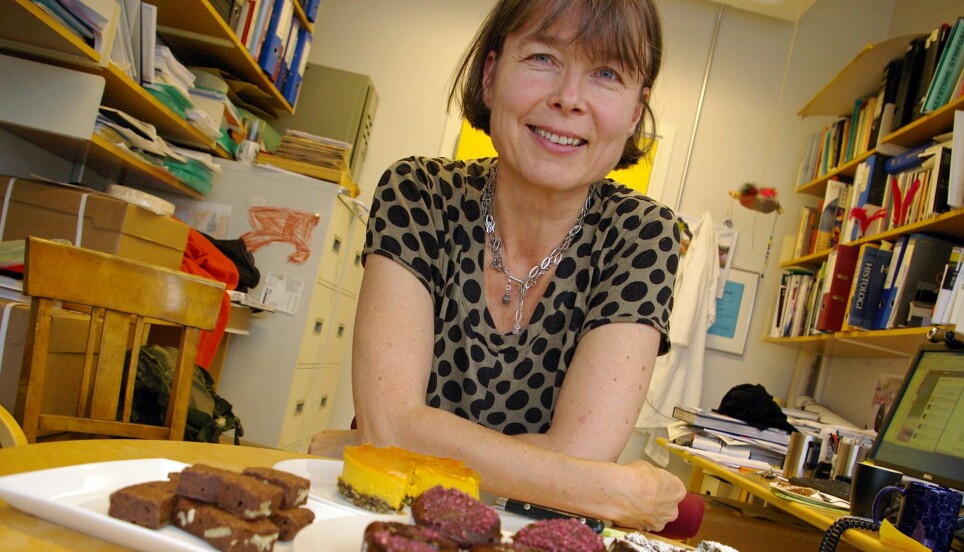
The chemistry of cake baking
Most cakes contain eggs, milk, flour and sugar. Now there’s a way to make them without one or more of these ingredients.
Denne artikkelen er over ti år gammel og kan inneholde utdatert informasjon.
Anne Spurkland is a doctor and professor of anatomy at the University of Oslo. She has researched autoimmune diseases for many years, particularly multiple sclerosis, and has extensive experience in lab research.
She also has a penchant for baking cakes.
Spurkland has friends who are allergic to milk and egg, and a few years ago her husband contracted coeliac disease. This caused her to start experimenting with cakes they all could eat.
Coeliac disease affects the small intestines and links to intolerance for the grain protein glutin. Consumption of grain products thus leads to an allergenic reaction in the small intestine.
Researching cakes

Spurkland has written a book on the art of baking tasty cakes without milk, flour, eggs and sugar. Here she compiled cake recipes in which these ingredients are replaced by other common household products.
She says her research and laboratory experiences came in handy when she experimented with pastries.
“I have good training in thinking systematically through a problem, and the reasoning required in baking and lab work has a lot in common.”
What is a cake, actually?
Spurkland started her work by giving consideration to what a cake really is, and what functions the various ingredients have.
According to her most Norwegians think of a cake as one baked in a form, rather airy, sweet and soft. And of course lots of cakes include frosting or whipped cream.
“My mission has been to develop something that could be served with coffee and be considered as a cake.”
She says this project wasn’t just about cakes.
"It was also a way of easily imparting what we in basic research actually do. Our knowledge can solve problems,” says Spurkland.
Scientists do things on a daily basis that are nearly impossible to explain, where the key is significance of the chemical properties of biological molecules.
“I’ve worked a lot with cakes in the same way as in research. But tasting cakes is a lot more accessible.”
Milk is the least important
According to Spurkland the least important ingredient of cakes, except cream cakes, is milk. And about 80 percent of the recipes in her book are milk free.
She says milk can usually be replaced by another liquid like water or juice.
Butter isn’t so important either.
“The taste of butter is great, but its chemical functions in baking can be achieved in other ways.”
What you need to replace butter is a fat mixture that can be solid and liquid at room temperature like butter, she adds.
Spurkland often replaces butter in her recipes with white shortening, coconut fat and coconut milk.
For example she has made lemon cream of lemon zest, lemon juice, sugar, corn starch, egg yolks and coconut fat.
Cakes without flour
Making cakes without wheat flour is no problem either, according to Spurkland.
Unless you are baking with yeast, wheat flour can usually be replaced by corn starch or potato starch.
“It works as long you are sticking to fluffy, spongy cakes and as long as you use eggs in the dough,” she says. “Wheat flour doesn’t have any taste, so it isn’t the taste people will be missing, it’s the consistence.”
Wheat flour is comprised of starchy grain covered in proteins.
Gluten is the name of the substance created when the proteins in the flour get moist.
When water is added, the proteins glutenin and gliadin absorb the liquid, stretching out and getting sticky. The more you knead the dough, the more gluten you get.
Gluten is good for getting bread to cling together but if you have too much of it in cakes they become tough and compact.
Corn and potato starch consist of starch only, with no proteins. This means you get the same stickiness from the starch when the dough is heated but you get no help from the proteins.
“This works fine as long as you have eggs in it,” says Spurkland.
Eggs take care of the process that normally comes from the proteins in wheat flour – keeping air in the dough, maintaining the shape of the cake during heating, keeping the water from evaporating out of the finished baked pastry or bread and blocking the starch from re-crystallising and making the cake dry.
Other replacements for wheat flour are rice flour, ground seeds and nuts or boiled beans and peas.
Pumpkins for eggs
It’s a lot harder when you strike eggs from a recipe. Eggs help put air in the dough and also keep the cake together.
“The consequences of removing eggs from cakes, are manifold,” says Spurkland.
“You can’t just replace eggs with one single other ingredient. So what you use instead depends on what qualities you are looking for.”
For instance in a cupcake recipe, she has replaced eggs with pumpkin.
She explains that when you beat pumpkin in a mixer the cells of the vegetable break apart. All of the cells have membranes, and these contain the same fats that are found in eggs.
So the mashed vegetable will have many of the same properties as the fats in eggs, such as the cohesive effect on water and fat.
The concentration of fats is much different than in eggs, but plants have a lot of complex carbohydrates.
“When the cells are crushed these will be released and contribute to trapping the air. These combine to give you the opportunity to mix air, sugar, water and fat, says Spurkland.
Sugar is a brain-teaser
The final and often the most difficult ingredient to remove is sugar. But fortunately there are some tricks for obtaining sweetness without it.
“I’ve used apricots, raisins and dates just for the sweetness.”
And then there’s the Maillard reaction. This is the name of the chemical reactions between the amino acids and proteins that occur during heating.
For instance it’s the Maillard reactions that explain why a sweet bun tastes and looks as it does if it is brushed with egg, milk and sugar before being popped into the oven. This is the reaction that gives a dark crust to pastries and cakes and it often triggers a sweet taste.
In cakes made without sugar, you may therefore still get sweetness.
Sugar is important despite it all
But sugar is often important for the structure in cakes. When you whip eggs and sugar, which most cake recipes will be asking you to do, the sugar increases the viscosity of the egg mixture so the air bubbles which get mixed in don’t pop straight away.
But this can also be solved because the sugar content in dried fruit is also high.
In Spurkland’s cookbook she describes an apricot cake that uses dried apricots as the sugar source.
But sugarless cakes are almost a self-contradiction. Most of the sugarless pastries in her book are the compact rather than the spongy kinds, such as pies and tarts, pancakes… and of course, the Norwegian lefse.
Translated by: Glenn Ostling































